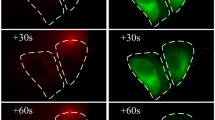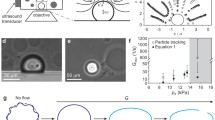Abstract
The ability of collapsing (cavitating) bubbles to focus and concentrate energy, forces and stresses is at the root of phenomena such as cavitation damage, sonochemistry or sonoluminescence1,2. In a biomedical context, ultrasound-driven microbubbles have been used to enhance contrast in ultrasonic images3. The observation of bubble-enhanced sonoporation4,5,6—acoustically induced rupture of membranes—has also opened up intriguing possibilities for the therapeutic application of sonoporation as an alternative to cell-wall permeation techniques such as electroporation7 and particle guns8. However, these pioneering experiments have not been able to pinpoint the mechanism by which the violently collapsing bubble opens pores or larger holes in membranes. Here we present an experiment in which gentle (linear) bubble oscillations are sufficient to achieve rupture of lipid membranes. In this regime, the bubble dynamics and the ensuing sonoporation can be accurately controlled. The use of microbubbles as focusing agents makes acoustics on the micrometre scale (microacoustics) a viable tool, with possible applications in cell manipulation and cell-wall permeation as well as in microfluidic devices.



Similar content being viewed by others
References
Suslick, K. S. Sonochemistry. Science 247, 1439–1445 (1990)
Hilgenfeldt, S., Grossmann, S. & Lohse, D. A simple explanation of light emission in sonoluminescence. Nature 398, 402–405 (1999)
Chang, D. C., Chassey, B. M., Saunders, J. A. & Sowers, A. E. (eds) Advances in Echo Imaging Using Contrast Enhancement (Kluwer Academic, Dordrecht, 1993)
Tachibana, K., Uchida, T., Ogawa, K., Yamashita, N. & Tamura, K. Induction of cell membrane porosity by ultrasound. Lancet 353, 1409 (1999)
Miller, D. L. & Quddus, J. Sonoporation of monolayer cells by diagnostic ultrasound activation of contrast-agent gas bodies. Ultrasound Med. Biol. 26, 661–667 (2000)
Ward, M., Wu, J. & Chiu, J.-F. Experimental study of the effects of Optison® concentration on sonoporation in vitro. Ultrasound Med. Biol. 26, 1169–1175 (2000)
Chang, D. C., Chassey, B. M., Saunders, J. A. & Sowers, A. E. (eds) Guide to Electroporation and Electrofusion (Academic, New York, 1992)
Seki, M., Komeda, Y., Iida, A., Yamada, Y. & Morikawa, H. Transient expression of beta-glucuronidase in Arabidopsis thaliana leaves and roots and Brassica napus stems using a pneumatic particle gun. Plant Mol. Biol. 17, 259–263 (1991)
Prosperetti, A. A new mechanism for sonoluminescence. J. Acoust. Soc. Am. 101, 2003–2007 (1997)
Popinet, S. & Zaleski, S. A front-tracking algorithm for accurate representation of surface tension. Int. J. Num. Meth. Fluids 30, 775–793 (1999)
Brujan, E.-A., Nahen, K., Schmidt, P. & Vogel, A. Dynamics of laser-induced cavitation bubbles near an elastic boundary. J. Fluid Mech. 433, 251–281 (2001)
Wang, Z. Q., Pecha, R., Gompf, B. & Eisenmenger, W. Single bubble sonoluminescence: Investigations of the emitted pressure wave with a fiber optic probe hydrophone. Phys. Rev. E 59, 1777–1780 (1999)
Hilgenfeldt, S., Lohse, D. & Zomack, M. Sound scattering and localized heat deposition of pulse-driven microbubbles. J. Acoust. Soc. Am. 107, 3530–3539 (2000)
Greenleaf, W. J., Bolander, M. E., Sarkar, G., Goldring, M. B. & Greenleaf, J. F. Artificial cavitation nuclei significantly enhance acoustically induced cell transfection. Ultrasound Med. Biol. 24, 587–595 (1998)
Rawicz, W., Olbrich, K., McIntosh, T., Needham, D. & Evans, E. Effect of chain length and unsaturation on elasticity of lipid bilayers. Biophys. J. 79, 328–339 (2000)
Boal, D. Mechanics of the Cell (Cambridge Univ. Press, Cambridge, UK, 2002)
Dimitrov, D. S. & Anguelova, M. I. Lipid swelling and liposome formation on solid surfaces. Prog. Colloid Polym. Sci. 73, 48–56 (1987)
Plesset, M. S. & Prosperetti, A. Bubble dynamics and cavitation. Annu. Rev. Fluid Mech. 9, 145–185 (1977)
Leighton, T. G. The Acoustic Bubble (Academic, London, 1994)
Lighthill, J. Acoustic streaming. J. Sound Vib. 61, 391–418 (1978)
Miller, D. L., Nyborg, W. L. & Whitcomb, C. C. Platelet aggregation induced by ultrasound under specialized conditions. Science 205, 505–507 (1979)
Miller, D. L. Particle gathering and microstreaming near ultrasonically activated micropores. J. Acoust. Soc. Am. 84, 1378–1387 (1988)
Elder, S. A. Cavitation microstreaming. J. Acoust. Soc. Am. 31, 54–64 (1958)
Davidson, B. J. & Riley, N. Cavitation microstreaming. J. Sound Vib. 15, 217–233 (1971)
Rooney, J. A. Hemolysis near an ultrasonically pulsating gas bubble. Science 169, 869–871 (1970)
Longuet-Higgins, M. S. Viscous streaming from an oscillating spherical bubble. Proc. R. Soc. Lond. A 454, 725–742 (1998)
Blake, J. R. & Chwang, A. T. Fundamental singularities of viscous flow. J. Eng. Math. 8, 23–29 (1974)
Pozrikidis, C. Boundary Integral and Singularity Methods for Linearized Viscous Flow (Cambridge Univ. Press, Cambridge, UK, 1992)
Riley, N. On a sphere oscillating in a viscous fluid. Q. J. Mech. Appl. Math. 19, 461–472 (1966)
Seifert, U. Fluid membranes in hydrodynamic flow fields: Formalism and an application to fluctuating quasispherical vesicles in shear flow. Eur. Phys. J. B 8, 405–415 (1999)
Acknowledgements
We thank D. Lohse for his support and insight, and A. van den Berg and H. Gardeniers for discussions.
Author information
Authors and Affiliations
Corresponding author
Ethics declarations
Competing interests
The authors declare that they have no competing financial interests.
Rights and permissions
About this article
Cite this article
Marmottant, P., Hilgenfeldt, S. Controlled vesicle deformation and lysis by single oscillating bubbles. Nature 423, 153–156 (2003). https://doi.org/10.1038/nature01613
Received:
Accepted:
Issue Date:
DOI: https://doi.org/10.1038/nature01613
- Springer Nature Limited
This article is cited by
-
Initiating and imaging cavitation from infused echo contrast agents through the EkoSonic catheter
Scientific Reports (2023)
-
Automated microparticle positioning using a pair of ultrasound-actuated microbubbles for microfluidic applications
Microfluidics and Nanofluidics (2023)
-
Passively and actively enhanced surface plasmon resonance sensing strategies towards single molecular detection
Nano Research (2022)
-
Pulsed-sonochemiluminescence combined with molecularly imprinted polymerized high internal phase emulsion adsorbent for determination of bentazone
Microchimica Acta (2022)
-
Automated monitoring and positioning of single microparticle via ultrasound-driven microbubble streaming
Microfluidics and Nanofluidics (2022)





